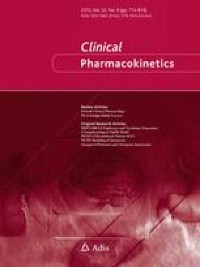|
Medicine by Alexandros G. Sfakianakis,Anapafseos 5 Agios Nikolaos 72100 Crete Greece,00302841026182,00306932607174,alsfakia@gmail.com,
Πληροφορίες
Ετικέτες
Κυριακή 24 Ιανουαρίου 2021
Pharmacokinetic and Pharmacodynamic Optimization of Antibiotic Therapy in Cystic Fibrosis Patients: Current Evidences, Gaps in Knowledge and Future Directions
Εγγραφή σε:
Σχόλια ανάρτησης (Atom)
Αρχειοθήκη ιστολογίου
-
►
2023
(276)
- ► Φεβρουαρίου (133)
- ► Ιανουαρίου (143)
-
►
2022
(1976)
- ► Δεκεμβρίου (116)
- ► Σεπτεμβρίου (158)
- ► Φεβρουαρίου (165)
- ► Ιανουαρίου (161)
-
▼
2021
(3661)
- ► Δεκεμβρίου (161)
- ► Σεπτεμβρίου (274)
- ► Φεβρουαρίου (64)
-
▼
Ιανουαρίου
(368)
- Type A aortic dissection developed after type B di...
- Hemosuccus pancreaticus caused by gastroduodenal a...
- Endoscopic treatment for acute appendicitis with c...
- Residual tumor and central lymph node metastasis a...
- Endoscopic salvage treatment of histoacryl after s...
- Immunosuppressant treatment for IgG4-related scler...
- Intraparenchymal hemorrhage after surgical decompr...
- Krukenberg tumor with concomitant ipsilateral hydr...
- Simultaneous bilateral acromial base fractures aft...
- Efficacy of cartilage conduction hearing aids in c...
- Identification of Prostaglandin F2 Receptor Negati...
- Complicated acute frontal sinusitis in a child pre...
- Nasopharyngeal microbiome analyses in otitis-prone...
- Comparative evaluation of improvement in periodont...
- Supraclinoid internal carotid artery blister-like ...
- Transoral robotic submandibular gland transpositio...
- Dynamic facial reanimation using active implantabl...
- A novel approach to the Basophil Activation Test f...
- Annular Flow in the Upper Esophageal Sphincter Dem...
- Primary diffuse large B-cell lymphoma of the major...
- Why Clinicians Choose Their Language Intervention ...
- Biomarkers in atopic dermatitis - a review on beha...
- Skin-resident natural killer T cells participate t...
- Acute Laryngeal Injury After Intubation
- Early Intervention for the Treatment of Acute Lary...
- De Novo vs Inverted Papilloma–Associated Sinonasal...
- Prevalence of anemia among patients with solid can...
- The Possible Role of Sclerostin in the Pathogenesi...
- Stem Cells and Gene Therapy in Progressive Hearing...
- 5 things to know about capnography and respiratory...
- The systemic inflammation response index predicts ...
- Age‐related dental phenotypes and tooth characteri...
- Efficacy and safety of sorafenib plus vitamin K tr...
- Circ_0008305‐mediated miR‐660/BAG5 axis contribute...
- Real world outcomes of combination and timing of i...
- Targeting YAP‐p62 signaling axis suppresses the EG...
- Plasmodium falciparum FIKK9.1 is a monomeric serin...
- Administrative coding in electronic health care re...
- IBCC chapter – Disseminated Intravascular Coagulat...
- Homologous recombination deficiency (HRD) score in...
- Papillary neoplasms of the breast—reviewing the sp...
- PI3k inhibitors (BKM120 and BYL719) as radiosensit...
- PI3k inhibitors (BKM120 and BYL719) as radiosensit...
- Clinical significance of quantitative categorizati...
- Molecular and immunophenotypic characterization of...
- Prism adaptation treatment to address spatial negl...
- EMCrit 290 – Decompensated Hypothyroidism and Myxe...
- Association between allergic rhinitis-related fact...
- Postoperative dysphagia immediately following pedi...
- Supraglottoplasty in the management of laryngomala...
- Association of perioperative ibuprofen exposure wi...
- Loss of smell and taste in COVID-19 infection in a...
- Plurality of perspective: Doctor-parents of deaf c...
- Profiles and predictors of auditory functioning in...
- Proposed ultrasound algorithm to differentiate thy...
- Could the Aid System Be Reinforcing Mental Health ...
- Narrativity and Referential Activity Predict Episo...
- Trends in gastrostomy tube placement with concomit...
- Therapeutic effectiveness of costal cartilage graf...
- Pharmacokinetic and Pharmacodynamic Optimization o...
- Fetal Physiologically Based Pharmacokinetic Models...
- Pharmacokinetics of Roxadustat: A Population Analy...
- Monte Carlo Simulations of the photo-thermal cance...
- A water stable Zn(II)-MOF for luminescent detectio...
- 11 C-Methionine PET/CT in patients with primary hy...
- Effectiveness of Eribulin in Metastatic Breast Can...
- Comparison Between Fusion and Non-Fusion Surgery f...
- Diagnostic Criteria for Gastro-esophageal Reflux F...
- Amitraz efficacy against Rhipicephalus microplus
- Comparative evaluation of amniotic fluid as an alt...
- Process- and Outcome-Based Financial Incentives to...
- Retained Endoscope: An Unexpected but Serious Comp...
- Hypofibrinogenemia can be estimated by the predict...
- Lenz microphthalmia syndrome in neurosurgical prac...
- Biological evaluation of the modified nano-amorpho...
- Physical exercise effects on the brain during COVI...
- How to prevent cassava poisoning,,,,,,,,,,,,,,,Cas...
- Anthropometric risk factors for ovarian cancer in ...
- A Controlled Accuracy-Based Recursive Algorithm fo...
- Postapproval trials versus patient registries: com...
- Life-threatening polymyositis with spontaneous hem...
- Anti-programmed cell death-1 therapy in octogenari...
- Safety and efficacy of electrochemotherapy in a se...
- Clinical outcomes and secondary glaucoma after gam...
- Morphea following treatment with pembrolizumab for...
- Transcriptional analysis of metastatic uveal melan...
- Hemophagocytic lymphohistiocytosis of a melanoma p...
- MicroRNAs expression associated with aggressive cl...
- Infusion reaction to nivolumab in a metastatic mel...
- Antibody-drug conjugates: an evolving approach for...
- The existence of butterfly effect and its impact o...
- Rare DICER1 and Absent FOXL2 Mutations Characteriz...
- Myoepithelioma-like Hyalinizing Epithelioid Tumor ...
- Gross Specimen Handling Procedures Do Not Impact t...
- Expanding the Spectrum of Microscopic and Cytogene...
- Clinicopathologic Features of Varicella Zoster Vir...
- Pseudocarcinomatous Squamous Hyperplasia Involving...
- Amyloid-like Fibronectin Deposits in the Liver: A ...
- Dedifferentiated and Undifferentiated Melanomas
- Correlation Between Immunohistochemistry and Seque...
-
►
2020
(4554)
- ► Δεκεμβρίου (400)
- ► Σεπτεμβρίου (381)
- ► Φεβρουαρίου (638)
- ► Ιανουαρίου (691)




Δεν υπάρχουν σχόλια:
Δημοσίευση σχολίου